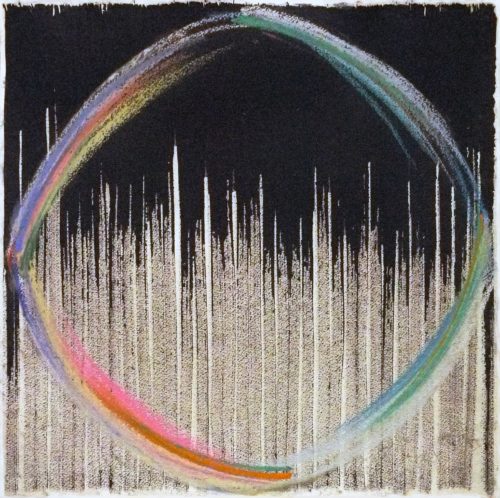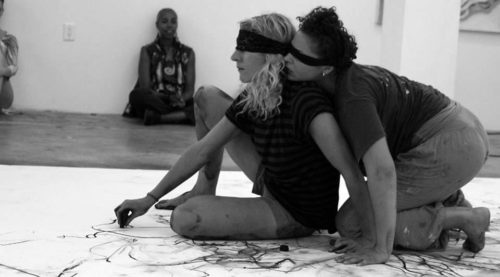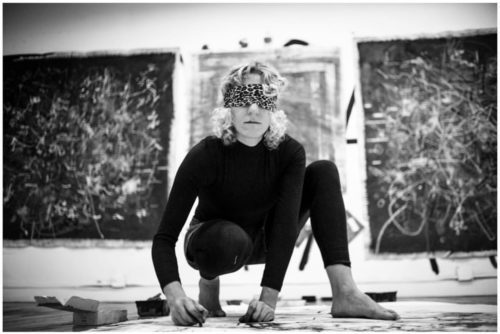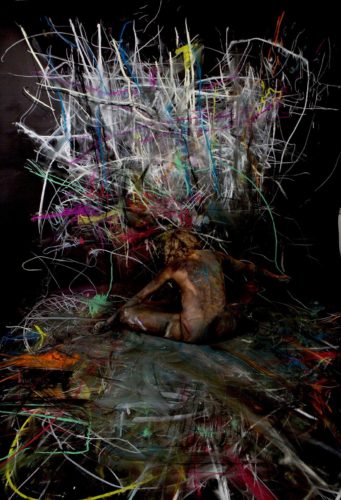Alexis Calvas recently sat down with London base artist Claire Zakiewicz in between her travels between London, Venice and New York City to discuss her recent works and inspiration.
Hello, Claire, can you tell me about your recent work and what type of projects you have been working on?
I am an interdisciplinary artist; I work mostly with painting, performance and video. Sound as well – that is mainly what my work is rooted in! I work between New York, London and increasingly Venice.
Your relationship between sound and drawing is very compelling. How did it begin?
I was always drawing, my mom encouraged everyone in our family to learn instruments from an early age, and my instrument was my saxophone. At university, I would get up in the morning go for a swim, then art school and paint all day – I was into print work at the time. In the evening I would play my saxophone and go to the jazz bar and open mic sessions. Sometimes I would busk. During the day I was in my own world and in the evening I was social and making music with people. That was my ideal. I often feel I have to choose one or the other. Painting is a lonely practice, I love it but I need balance. I kept brainstorming different ways to integrate my musical life and my visual art life. One of my first projects was in Cuba. I was 20 and recorded sounds the whole time. I then painted a box that held speakers playing my sound pieces.
Beautiful. Your trajectory then leads you into music producing. Creating sound with electronics, Djing and then eventually having ensembles perform with you whilst you paint. Can you give us a little more detail?
I started working with electronics that would trigger sounds, like pressure matts, for example. I built these environments where you would walk through and sounds would be triggered. For me, this seemed clunky. There was sound and visual art but they were still quite separated. I then met a composer who I worked very closely with for about ten years, Alwynne Pritchard. She is a classical composer but she works with graphic scores, theatre performance and movement. When I started DJing and producing music and she invited me to Norway for a residency. It was there that I had the idea of drawing with a musical ensemble.
I really enjoy being a part of an ensemble. I do acting classes, like the ones when you Go Here, as a way of exploring gesture and mark making. Once, when I was doing an acting class we had to craft a character. I then started to build scenarios where my character was trapped in a universe where she has to communicate with through automatic writing. I was later working with dancers and actors who do shamanic work. They worked with energy and healing in addition to their art practice so they had methods of working with energy whilst I was moving and painting. At one point I reduced myself to a paintbrush and would be totally submissive. The audience does not have to understand all the details, but it was a way to explore a deeper listening, or a deeper looking and being connected to one another. It was really beautiful to do that.
Drawing sound, what does that mean to you?
For me, drawing from sight is a practice that helps me look more deeply and drawing sound is about really listening more deeply. Sound is vibration and it resonates, it can have rhythm, pitch changes, tension and resolution. There are many connections between sound and drawing and many artists have explored the connections through images, motifs and performance. Mostly my work is about the activity of drawing but I also work with various motifs and visual structures.
I did a residency in New York in 2013. Prior to that I had been working at the university. I was completely by myself, away from family and friends and I had a bit of pressure to come up with some work. I felt the pressure of people watching me. I went into my own desires of what I wanted to paint. On the first day of the residency I wanted black paper but I only had white so I painted the paper black in a performative way following my breathe in a rhythm across the page. When I finished it looked like the skyline of New York, which was just so crazy as I had just arrived. This drawing became my motif whilst I was there. I then started using curves following the hinge joints of my wrists, elbows and shoulders and rotating the page in a rhythmic way that creates circles – another one of my motifs. Sometimes I layer my paintings to play with perspective and dimensionality. Other times I play with the frame – for me a drawing is a container and the lines of the frame are meaningful. Another element in my drawings is, of course, the gesture, and that comes out of automatic drawing – moving to the sound with a drawing implement, possibly also automatic writing – using signs or symbols in response to the sound. Sometimes the gestures are very intentional and other times I use accidental or incidental marks.
Being blindfolded is a big part of your practice. How did that come about?
When I was doing my masters I was listening to sound and scribbling all the time, I think it may have been my brother who said “Claire you should close your eyes, it is not about looking it is about listening”. So I started drawing with my eyes closed. When you take something away the rest enlarges. I find it to be a great way to focus on sound, movement and just being in the moment.
Is there anyone that has really impacted your life?
I really have to give it to Alwynne Pritchard. She is ten years older than me and just finished a PhD when I met her. She was like “why don’t you bring your DJ equipment and come do this residency for 2 weeks in Norway”. I was the only visual artist and the youngest one. Everyone was very academic and at the top of their game. I felt so lucky to work with them. Improvisation was a great way to bring together artists from different disciplines. We learnt how to understand, listen and respond across disciplines and it made my life richer.
You have so many opportunities in so many cities, how did you get here?
A lot of people forget about the push and trust in the process and instead seek instant gratification. It would be impossible to do it instantly. It would drive someone mad. There are some moments that have been super exciting and really great luck. And others times were scary and challenging. It has taken a long time and I have had to learn so many things about different aspects of my life.
I am a fan of your solo show, the aesthetics of failure. Can you dig deeper into how your practice is resolving failure through the unexpected?
That was the work I am most happy with. Things came together in a very positive way. Four years ago I was working in a studio in Brooklyn, during my acting classes the teacher asked us to read the book, Zen in the Art of Archery by Eugen Herrigel. There was a lot of stuff in the book related to the aesthetics of failure, the practice of not aiming for the target. If you don’t aim you are more likely to hit the target, so long as you have practiced enough and are in the right state of mind. At the end of the book it explained how in Japan there is an ancient wisdom about how if you want to be a master at something than you have to be a master at teaching that thing. It made me think of what I would want to teach and be a master of.
The one thing that I have learnt working in my studio for long hours for a long period of time is about failure and struggle. It is like when you’re running and you want to give up and you just push through there is a moment where you overcome something and get a rush of endorphins. It feels fantastic. It is really similar when I am working long hours in the studio, my paintings are not going well. I hate them. I want to give up and throw them in a bin and go home. Now I recognize this feeling. I am at a point where I could possibly have a breakthrough if I keep pushing on but I need to find that breakthrough. It is learning how to recognize this and keep going. Allow yourself to give up sometimes as well. Then, I might do some creative destruction, destroy the whole thing and then something emerges.
I had this thought to develop a training course, which I ended up practicing on 15 friends called Making Bad Art The Permission to Fail. We would practice not aiming for the target and see what happened. My acting teacher in London, Dannie-Lu Carr, is a creativity coach and she wanted us to work together on this idea. Then out of the blue a philosophy professor called Andy Hamilton contacted me and said he just wrote an essay on the aesthetics of imperfection and was turning it into a book. He wanted a visual artist to contribute which was all very serendipitous as I just revisited his essay in my studio a few days before. We had a year and a half to write our contributions and during that time I had a lot of Skype conversations about the ideas of the aesthetics of imperfection. I decided to call it the aesthetics of failure, and the solo show in Venice was an exhibition of paintings, performances and videos made alongside writing the chapter.
What books have inspired you?
I came across an analytical psychologist called Daniel Stern who wrote some really important books for me. The Interpersonal World of the Infant was a big one for me, also Forms of Vitality. He talked about what he called vitality effect contours, those dynamic rushes of feeling that we experience as soon as we are born. Before we think, conceptualize things, before language we experience rushes of feeling so initially it’s how we experience the world. We are able to start communicating to our caregiver through these rushes of feeling that can attune to others. The mother can communicate through sound and movement. The baby and mother communicate without words. He says this forms the basis of our appreciation of art and ability to move to music and dance with one another. Language comes in later. I wanted to get to the core of the human experience across cultures, a global human experience that can help me to understand what art is and our appreciation of art.
Another book is the Phenomenology of Dance by Maxine Sheets-Johnstone. I thought this was perfect for my work, it just really made sense in terms of understanding what I am doing when I am drawing sound and what it is that we perceive. How objects can be multi-model and translatable in different modes of perception.
You have a very experimental practice; in one of your works you switched positions with the dancer and the musician?
It was hilarious to swap roles. We had so much fun doing that. This came from the idea of making bad art and the permission to fail. And reading the other chapters in the book the Aesthetics of Imperfection. Drawing with the un-favored hand, letting go of controlling what you are able to do. I used to do sound clashes’ haven’t done one in ages but it was experimental DJing where I would work with someone with too many programs open. Very low fi. We would try to control what was out of control. We set ourselves up for failure. When I went to go DJ normally everything was so easy. It is a fun practice.
As an artist, a DJ, and a writer, what is your experience navigating these worlds as a woman?
When I started DJing, I definitely felt judgment. It could have partly been a projection or my imagination but I think it was definitely real as well. There were quite often men who would stand there and just judge me. They would come up to me and say that was a good set but I felt like I had to try harder and not make any mistakes. It was novelty to be a girl DJ. There weren’t many others. Nowadays things are quite different.
I was just in an exhibition last Saturday that was all women. As part of the same show I am hosting a panel and we have two men on the panel. There was hesitance to have men on the panel, as people wanted it to be a female only show. I have been staying at a residency called the Mothership in New York and again that is mostly female, she doesn’t rule men out completely, men can stay there but she prefers it to be woman only. I feel that over the past couple of years when I go to the Venice Biennale and the Miami Art Fair there are so many more female artists now than there used to be. There was a giant leap and there are more female curators now. I think that is really good.
Why is it important to work with woman and break all male line ups?
I work with a lot of woman. A collaborator of mine didn’t want men on the panel, as there was a belief that we have had so many centuries of being told the “Truth” by men. She doesn’t want that anymore. I recently met an older artist and told him about the panel I was moderating – the title was Art as Spiritual Practice. He went off on this lecture and I thought that was a good example of being told the “Truth”. He didn’t ask me any questions about it he just lectured me.
Amen. Lets talk about mentorship. You spoke about the composer who was ten years older than you and your acting coach. Is mentorship important to you?
Definitely, it really has been a valuable part of my practice. I hope that it will continue as it is something that comes from collaboration. I am 41 now and working with younger artists as well. Up until recently I was only working older artists and felt like I had a lot of mentors and I didn’t really have any mentees. But now, especially being at the Mothership in Brooklyn, I was one of the older ones. You learn just as much whatever position and age you are in. Being a mentor brings something else super valuable and important. It can go both ways.
Why is collaboration so important?
It is a way to keep learning. It is difficult to keep learning. You can easily become like a machine and produce things you know to work. Then you can become really afraid of producing something experimental because you have become so used to success constantly. I personally do not want to be an artist who is in that position.
Alexis Calvas is an interdisciplinary researcher, creative producer, and socially engaged facilitator. Her work explores socio-political content, combining academic theory with artistic practice to actively encourage people to think about their relationship to society in radical and imaginative ways. She is currently conducting a PhD on borders, technology, and humanitarian abuse in the War Studies Department at King’s College London and works as an Associate Lecturer at UAL’s Camberwell College of Arts.







